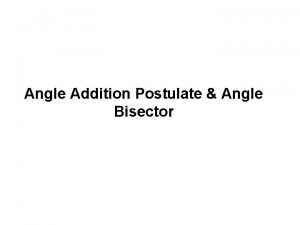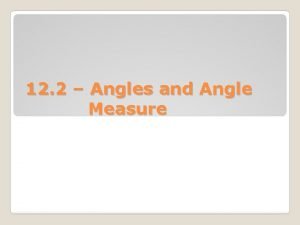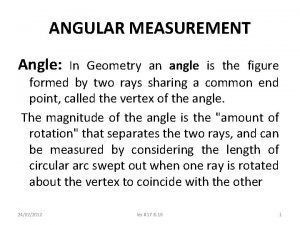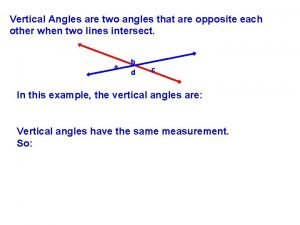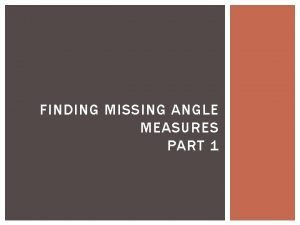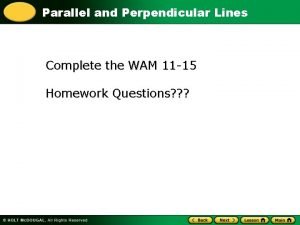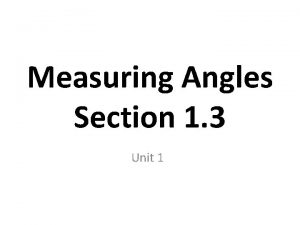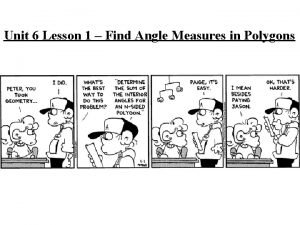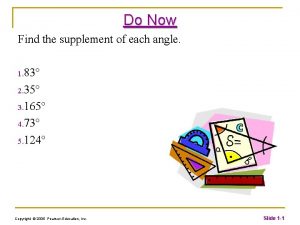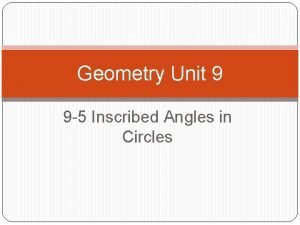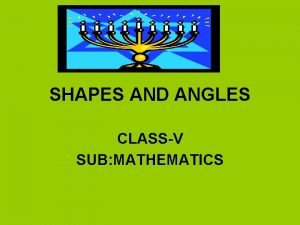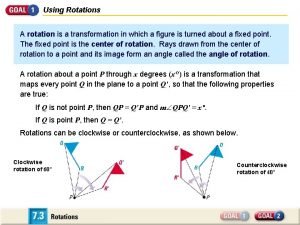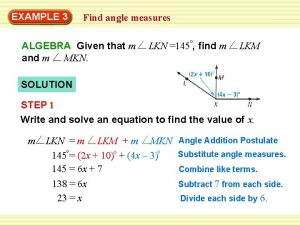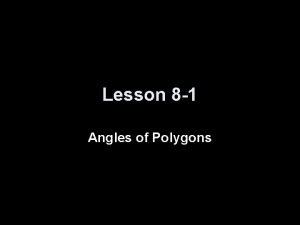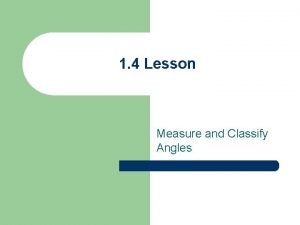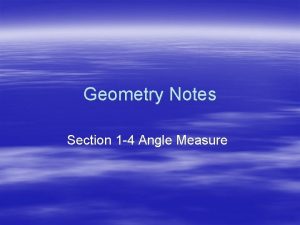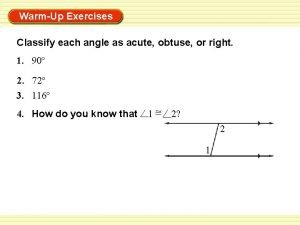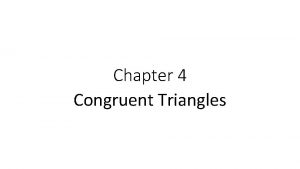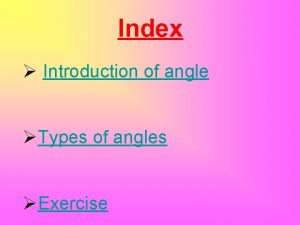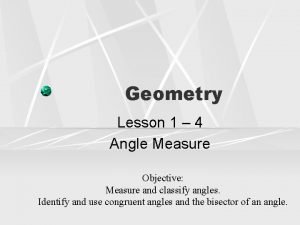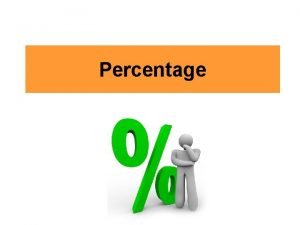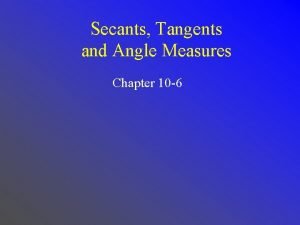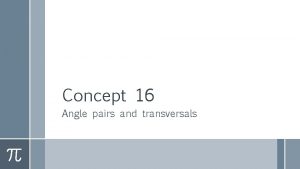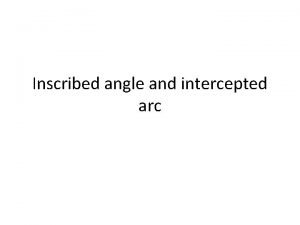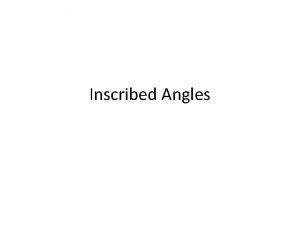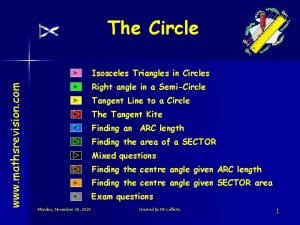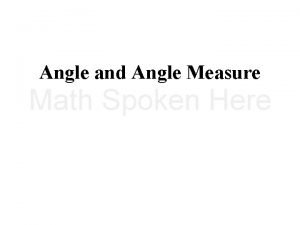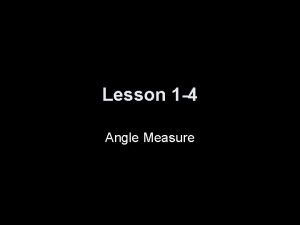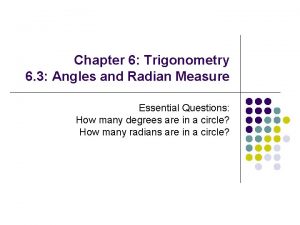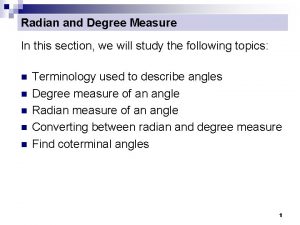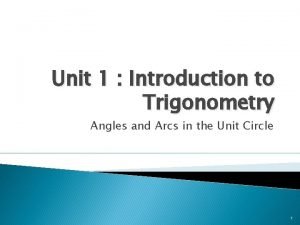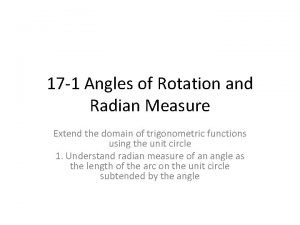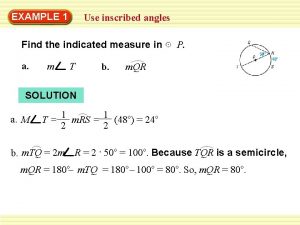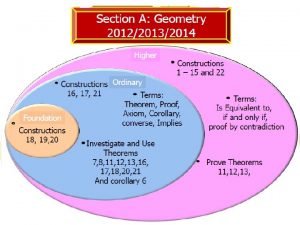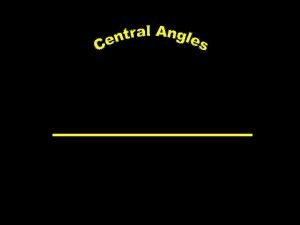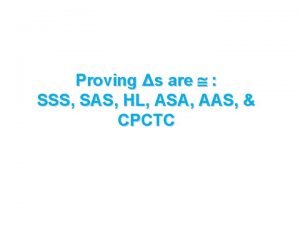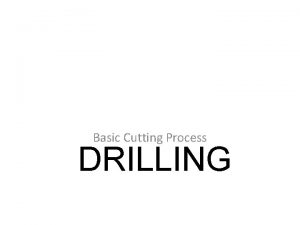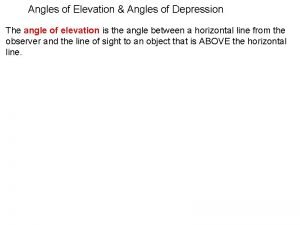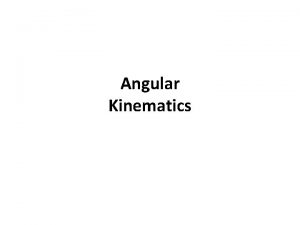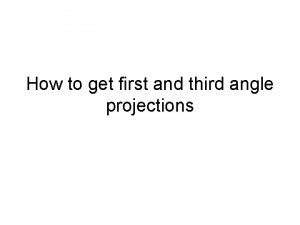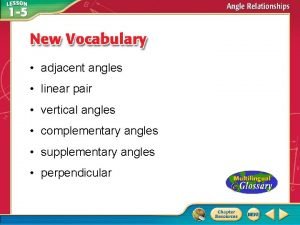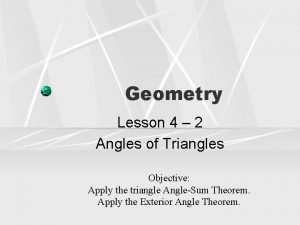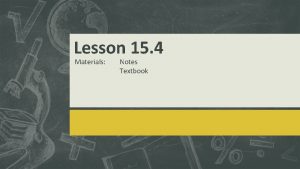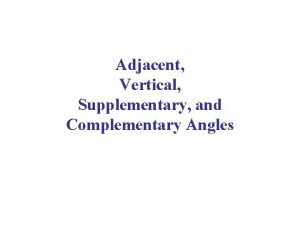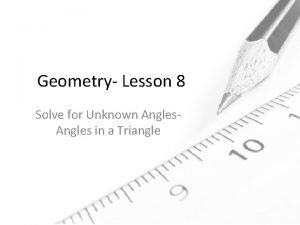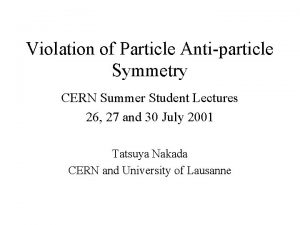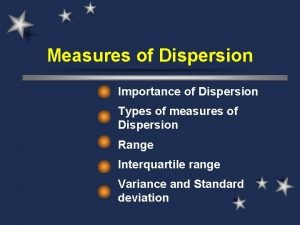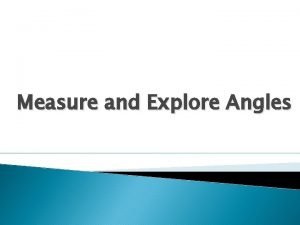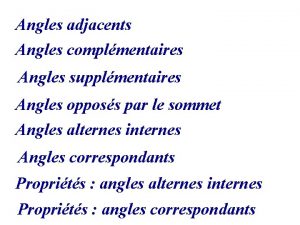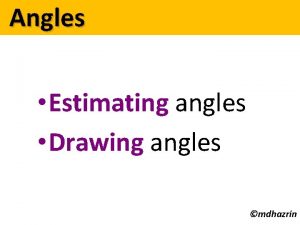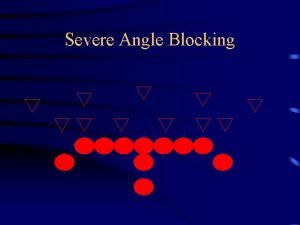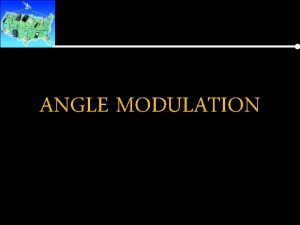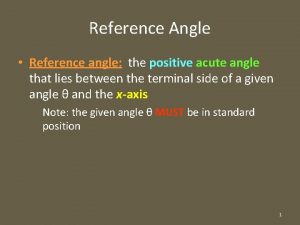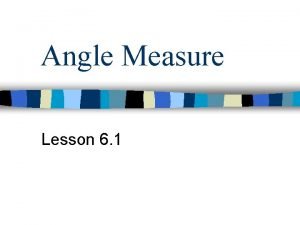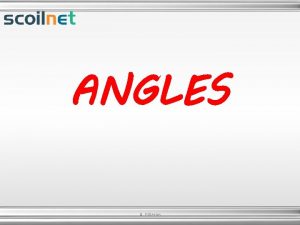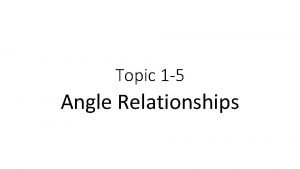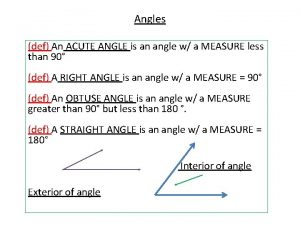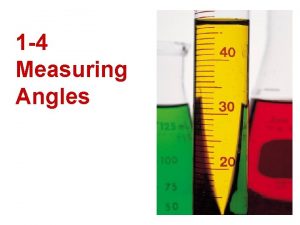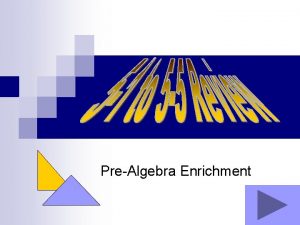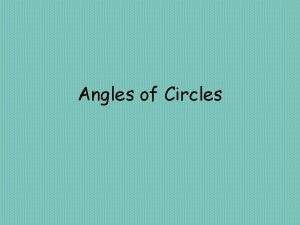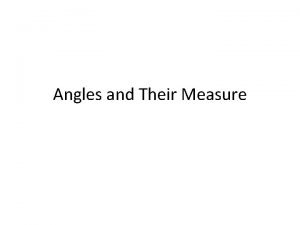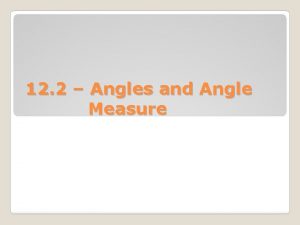Angles 3 1 Angles 3 2 Angle Measure









































































- Slides: 73

Angles Ø Ø Ø Ø § 3. 1 Angles § 3. 2 Angle Measure § 3. 3 The Angle Addition Postulate § 3. 4 Adjacent Angles and Linear Pairs of Angles § 3. 5 Complementary and Supplementary Angles § 3. 6 Congruent Angles § 3. 7 Perpendicular Lines

Angles You will learn to name and identify parts of an angle. 1) Opposite Rays 2) Straight Angle 3) Angle 4) Vertex 5) Sides 6) Interior 7) Exterior

Angles Opposite rays are two rays that are part of a the same line and have only their ______ endpoints in common. Y X Z opposite rays XY and XZ are ______. straight angle The figure formed by opposite rays is also referred to as a ______. Straight Angle (Video)

Angles There is another case where two rays can have a common endpoint. angle This figure is called an _____. Some parts of angles have special names. S The common endpoint is called the ______, vertex sid e and the two rays that make up the sides of the angle are called the sides of the angle. R vertex side T

Angles There are several ways to name this angle. 1) Use the vertex and a point from each side. SRT or TRS S e The vertex letter is always in the middle. sid 2) Use the vertex only. R If there is only one angle at a vertex, then the angle can be named with that vertex. R vertex 3) Use a number. 1 1 side T

Angles An angle is a figure formed by two noncollinear rays that have a common endpoint. D Symbols: Definition of Angle E DEF FED 2 E F 2 Naming Angles (Video)

Angles 1) Name the angle in four ways. ABC C A CBA 1 B 2) Identify the vertex and sides of this angle. vertex: sides: Point B BA and BC

Angles 1) Name all angles having W as their vertex. X 1 2 W 1 2 XWZ Y 2) What are other names for XWY or 1? YWX 3) Is there an angle that can be named No! Z W?

Angles An angle separates a plane into three parts: interior 1) the ______ exterior 2) the ______ angle itself 3) the _____ In the figure shown, point B and all other points in the blue region are in the interior of the angle. Point A and all other points in the green region are in the exterior of the angle. Points Y, W, and Z are on the angle. W A Y Z interior B

Angles Is point B in the interior of the angle, exterior of the angle, or on the angle? P G Exterior Is point G in the interior of the angle, exterior of the angle, or on the angle? On the angle Is point P in the interior of the angle, exterior of the angle, or on the angle? Interior B

§ 3. 2 Angle Measure You will learn to measure, draw, and classify angles. 1) Degrees 2) Protractor 3) Right Angle 4) Acute Angle 5) Obtuse Angle

§ 3. 2 Angle Measure degrees In geometry, angles are measured in units called _______. The symbol for degree is °. P In the figure to the right, the angle is 75 degrees. In notation, there is no degree symbol with 75 because the measure of an angle is a real number with no unit of measure. 75° Q R m PQR = 75

§ 3. 2 Angle Measure For every angle, there is a unique positive number between 0 __ and ____ called 180 the degree measure of the angle. Postulate 3 -1 Angles Measure Postulate A B m ABC = n and 0 < n < 180 n° C

§ 3. 2 Angle Measure protractor to measure angles and sketch angles of given You can use a _____ measure. Use a protractor to measure SRQ. 1) Place the center point of the protractor on vertex R. Align the straightedge with side RS. 2) Use the scale that begins with 0 at RS. Read where the other side of the angle, RQ, crosses this scale. Q R S

§ 3. 2 Angle Measure Find the measurement of: m SRQ = 180 m SRJ = 45 m SRG = 150 m SRH 70 m QRG = 180 – 150 = 30 m GRJ = 150 – 45 = 105 H J G Q R S

§ 3. 2 Angle Measure Use a protractor to draw an angle having a measure of 135. 1) Draw AB 2) Place the center point of the protractor on A. Align the mark labeled 0 with the ray. 3) Locate and draw point C at the mark labeled 135. Draw AC. C A B

§ 3. 2 Angle Measure Once the measure of an angle is known, the angle can be classified as one of three types of angles. These types are defined in relation to a right angle. Types of Angles A obtuse angle 90 < m A < 180 A A right angle m A = 90 acute angle 0<m A < 90 Angle Classification (Video)

§ 3. 2 Angle Measure Classify each angle as acute, obtuse, or right. 110° 40° 90° Obtuse Right Acute 50° 130° Acute Obtuse 75° Acute

§ 3. 2 Angle Measure The measure of Solve for x. B is 138. The measure of Solve for y. 9 y + 4 H is 67. H 5 x - 7 B Given: (What do you know? ) B = 5 x – 7 and 5 x – 7 = 138 5 x = 145 x = 29 B = 138 Check! 5(29) -7 = ? 145 -7 = ? 138 = 138 (What do you know? ) H = 9 y + 4 and 9 y + 4 = 67 9 y = 63 y=7 H = 67 Check! 9(7) + 4 = ? 63 + 4 = ? 67 = 67

? ? ? Is m a larger than m 60° b? 60°


§ 3. 3 The Angle Addition Postulate You will learn to find the measure of an angle and the bisector of an angle. NOTHING NEW!

§ 3. 3 The Angle Addition Postulate 1) Draw an acute, an obtuse, or a right angle. Label the angle RST. R 45° 2) Draw and label a point X in the interior of the angle. Then draw SX. X 75° S 3) For each angle, find m RSX, m XST, and RST. 30° T

§ 3. 3 The Angle Addition Postulate 1) How does the sum of m RSX and m XST compare to m RST ? Their sum is equal to the measure of RST. m XST = 30 + m RSX = 45 = m RST = 75 R 2) Make a conjecture about the relationship between the two smaller angles and the larger angle. 45° X The sum of the measures of the two smaller angles is equal to the (Video) measure The Angle Addition Postulate of the larger angle. 75° S 30° T

§ 3. 3 The Angle Addition Postulate For any angle PQR, if A is in the interior of PQR, then m PQA + m AQR = m PQR. Postulate 3 -3 Angle Addition Postulate P Q 1 2 A m 1 + m 2 = m PQR. R There are two equations that can be derived using Postulate 3 – 3. m 1 = m PQR – m 2 = m PQR – m 1 These equations are true no matter where A is located in the interior of PQR.

§ 3. 3 The Angle Addition Postulate Find m 2 if m XYZ = 86 and m 1 = 22. m 2 + m 1 = m XYZ m 2 = m XYZ – m 1 Postulate 3 – 3. X 1 W 2 m 2 = 86 – 22 m 2 = 64 Z Y

§ 3. 3 The Angle Addition Postulate Find m ABC and m CBD if m ABD = 120. m ABC + m CBD = m ABD Postulate 3 – 3. 2 x + (5 x – 6) = 120 Substitution 7 x – 6 = 120 Combine like terms 7 x = 126 Add 6 to both sides x = 18 Divide each side by 7 36 + 84 = 120 C m ABC = 2 x m CBD = 5 x – 6 m ABC = 2(18) m CBD = 5(18) – 6 m ABC = 36 m CBD = 90 – 6 m CBD = 84 D (5 x – 6)° 2 x° A B

§ 3. 3 The Angle Addition Postulate Just as every segment has a midpoint that bisects the segment, every angle ray that bisects the angle. has a ___ angle bisector. This ray is called an ______

§ 3. 3 The Angle Addition Postulate The bisector of an angle is the ray with its endpoint at the vertex of the angle, extending into the interior of the angle. The bisector separates the angle into two angles of equal measure. Definition of an Angle Bisector P Q is the bisector of PQR. 1 2 A m 1 = m 2 R

§ 3. 3 The Angle Addition Postulate If bisects CAN and m CAN = 130, find 1 and 2. Since bisects CAN, 1 = 2. N 1 + 2 = CAN Postulate 3 - 3 1 + 2 = 130 Replace CAN with 130 1 + 1 = 130 Replace 2 with 1 2( 1) = 130 ( 1) = 65 Since 1 = 2, T Combine like terms 2 Divide each side by 2 2 = 65 1 C A


Adjacent Angles and Linear Pairs of Angles You will learn to identify and use adjacent angles and linear pairs of angles. When you “split” an angle, you create two angles. The two angles are called adjacent angles _______ B A D 2 1 adjacent = next to, joining. C 1 and 2 are examples of adjacent angles. They share a common ray. Name the ray that 1 and 2 have in common. ____

Adjacent Angles and Linear Pairs of Angles Adjacent angles are angles that: A) share a common side B) have the same vertex, and C) have no interior points in common Definition of Adjacent Angles J R M 2 1 1 and 2 are adjacent with the same vertex R and common side N

Adjacent Angles and Linear Pairs of Angles Determine whether 1 and 2 are adjacent angles. No. They have a common vertex B, but _______ no common side 2 1 B 1 Yes. They have the same vertex G and a common side with no interior points in common. 2 G N L J 2 1 No. They do not have a common vertex or a common side ______ The side of 1 is ____ The side of 2 is ____

Adjacent Angles and Linear Pairs of Angles Determine whether 1 and 2 are adjacent angles. No. 1 2 Yes. 1 X 2 D Z In this example, the noncommon sides of the adjacent angles form a straight line ______. linear pair These angles are called a _____

Adjacent Angles and Linear Pairs of Angles Two angles form a linear pair if and only if (iff): A) they are adjacent and B) their noncommon sides are opposite rays A D B 1 Definition of Linear Pairs C 2 1 and 2 are a linear pair.

Adjacent Angles and Linear Pairs of Angles In the figure, and are opposite rays. H 1) Name the angle that forms a linear pair with 1. T ACE A 2 1 ACE and 1 have a common side the same vertex C, and opposite rays , 3 4 C M and 2) Do 3 and TCM form a linear pair? Justify your answer. No. Their noncommon sides are not opposite rays. E


§ 3. 5 Complementary and Supplementary Angles You will learn to identify and use Complementary and Supplementary angles

§ 3. 5 Complementary and Supplementary Angles Two angles are complementary if and only if (iff) the sum of their degree measure is 90. E D A Definition of Complementary B 30° 60° F C Angles m ABC + m DEF = 30 + 60 = 90

§ 3. 5 Complementary and Supplementary Angles If two angles are complementary, each angle is a complement of the other. ABC is the complement of DEF and DEF is the complement of ABC. E D A B 30° 60° F C Complementary angles DO NOT need to have a common side or even the same vertex.

§ 3. 5 Complementary and Supplementary Angles Some examples of complementary angles are shown below. 75° 15° H P 40° m H + m I = 90 Q m PHQ + m QHS = 90 50° H S U T I 60° Z V m TZU + m VZW = 90 30° W

§ 3. 5 Complementary and Supplementary Angles If the sum of the measure of two angles is 180, they form a special pair of angles called supplementary angles. Two angles are supplementary if and only if (iff) the sum of their degree measure is 180. D C Definition of Supplementary Angles 50° A 130° B E m ABC + m DEF = 50 + 130 = 180 F

§ 3. 5 Complementary and Supplementary Angles Some examples of supplementary angles are shown below. H 75° 105° I m H + m I = 180 Q 130° 50° m PHQ + m QHS = 180 H P S U V 60° 120° 60° Z T m TZU + m UZV = 180 and m TZU + m VZW = 180 W


§ 3. 6 Congruent Angles You will learn to identify and use congruent and vertical angles. measure Recall that congruent segments have the same ____. Congruent angles also have the same measure. ________

§ 3. 6 Congruent Angles Two angles are congruent iff, they have the same degree measure _______. Definition of Congruent B V iff Angles 50° B V m B = m V

§ 3. 6 Congruent Angles To show that 1 is congruent to 2, we usearcs ____. 1 2 To show that there is a second set of congruent angles, X and Z, we use double arcs. This “arc” notation states that: X Z m X = m Z X Z

§ 3. 6 Congruent Angles four angles are formed. When two lines intersect, ____ There are two pair of nonadjacent angles. vertical angles These pairs are called _______. 4 1 3 2

§ 3. 6 Congruent Angles Two angles are vertical iff they are two nonadjacent angles formed by a pair of intersecting lines. Vertical angles: Definition of Vertical Angles 4 1 3 1 and 3 2 2 and 4

§ 3. 6 Congruent Angles 1) On a sheet of paper, construct two intersecting lines that are not perpendicular. 2) With a protractor, measure each angle formed. 3) Make a conjecture about vertical angles. Consider: A. 1 is supplementary to 4. m 1 + m 4 = 180 B. 3 is supplementary to 4. m 3 + m 4 = 180 Therefore, it can be shown that 1 3 Likewise, it can be shown that 2 4 4 1 3 2

§ 3. 6 Congruent Angles 4 1) If m 1 = 4 x + 3 and the m 3 = 2 x + 11, then find the m 3 x = 4; 3 = 19° 2) If m 2 = x + 9 and the m 3 = 2 x + 3, then find the m 4 x = 56; 4 = 65° 3) If m 2 = 6 x - 1 and the m 4 = 4 x + 17, then find the m 3 x = 9; 3 = 127° 4) If m 1 = 9 x - 7 and the m 3 = 6 x + 23, then find the m 4 x = 10; 4 = 97° 1 3 2

§ 3. 6 Congruent Angles Vertical angles are congruent. Theorem 3 -1 Vertical Angle Theorem m n 2 1 3 3 1 4 2 4

§ 3. 6 Congruent Angles Find the value of x in the figure: The angles are vertical angles. 130° x° So, the value of x is 130°.

§ 3. 6 Congruent Angles Find the value of x in the figure: The angles are vertical angles. (x – 10)° (x – 10) = 125. x – 10 = 125° x = 135.

§ 3. 6 Congruent Angles Suppose two angles are congruent. What do you think is true about their complements? 1 2 1 + x = 90 x is the complement of 1 x = 90 - 1 2 + y = 90 y is the complement of 2 y = 90 - 2 Because 1 2, a “substitution” is made. x = 90 - 1 x=y y = 90 - 1 x y If two angles are congruent, their complements are congruent.

§ 3. 6 Congruent Angles Theorem 3 -2 If two angles are congruent, then their complements are congruent _____. The measure of angles complementary to A and B is 30. 60° A B A B If two angles are congruent, then their supplements are congruent _____. Theorem 3 -3 The measure of angles supplementary to 1 and 4 is 110° 70° 4 3 2 4 1 70° 1

§ 3. 6 Congruent Angles If two angles are complementary to the same angle, congruent then they are _____. Theorem 3 -4 3 is complementary to 4 5 is complementary to 4 3 5 3 4 5 If two angles are supplementary to the same angle, congruent then they are _____. Theorem 3 -5 1 is supplementary to 2 3 1 3 is supplementary to 2 1 3 2

§ 3. 6 Congruent Angles Suppose A B and m A = 52. Find the measure of an angle that is supplementary to B. A B 52° B + 1 = 180 – B 1 = 180 – 52 1 = 128° 1

§ 3. 6 Congruent Angles If 1 is complementary to 3, 2 is complementary to 3, and m 3 = 25, What are m 1 and m 2 ? m 1 + m 3 = 90 Definition of complementary angles. m 1 = 90 - m 3 Subtract m 3 from both sides. m 1 = 90 - 25 Substitute 25 in for m 3. m 1 = 65 Simplify the right side. You solve for m 2 + m 3 = 90 Definition of complementary angles. m 2 = 90 - m 3 Subtract m 3 from both sides. m 2 = 90 - 25 Substitute 25 in for m 3. m 2 = 65 Simplify the right side.

§ 3. 6 Congruent Angles G D 1 A 4 3 2 B E 1) If m 1 = 2 x + 3 and the m 3 = 3 x - 14, then find the m 3 x = 17; 3 = 37° H 2) If m ABD = 4 x + 5 and the m DBC = 2 x + 1, then find the m EBC x = 29; EBC = 121° 3) If m 1 = 4 x - 13 and the m 3 = 2 x + 19, then find the m 4 x = 16; 4 = 39° 4) If m EBG = 7 x + 11 and the m EBH = 2 x + 7, then find the m 1 x = 18; 1 = 43° C

Suppose you draw two angles that are congruent and supplementary. What is true about the angles?

§ 3. 6 Congruent Angles If two angles are congruent and supplementary right angle then each is a _____. Theorem 3 -6 1 is supplementary to 2 1 and 2 = 90 1 2 congruent All right angles are _____. Theorem 3 -7 C A B A B C

§ 3. 6 Congruent Angles If 1 is supplementary to 4, 3 is supplementary to 4, and m 1 = 64, what are m 3 and m 4? 1 3 They are vertical angles. A 2 E 1 4 m 1 = m 3 D 3 is supplementary to 4 Given 64 + m 4 = 180 – 64 m 4 = 116 3 C m 3 = 64 m 3 + m 4 = 180 B Definition of supplementary.


§ 3. 7 Perpendicular Lines You will learn to identify, use properties of, and construct perpendicular lines and segments.

§ 3. 7 Perpendicular Lines perpendicular lines Lines that intersect at an angle of 90 degrees are _________. In the figure below, lines are perpendicular. A C 1 2 3 4 B D

§ 3. 7 Perpendicular Lines Perpendicular lines are lines that intersect to form a right angle. m Definition of Perpendicular Lines n

§ 3. 7 Perpendicular Lines In the figure below, l m. The following statements are true. m 2 1 3 4 l 1) 1 is a right angle. Definition of Perpendicular Lines 2) 1 3. Vertical angles are congruent 3) 1 and 4 form a linear pair. Definition of Linear Pair 4) 1 and 4 are supplementary. Linear pairs are supplementary 5) 4 is a right angle. m 4 + 90 = 180, m 4 = 90 6) 2 is a right angle. Vertical angles are congruent

§ 3. 7 Perpendicular Lines If two lines are perpendicular, then they form four right angles. a Theorem 3 -8 2 1 3 4 b

§ 3. 7 Perpendicular Lines 1) PRN is an acute angle. False. 2) 4 8 True

§ 3. 7 Perpendicular Lines If a line m is in a plane and T is a point in m, then there exists exactly ___ one line in that plane that is perpendicular to m at T. m Theorem 3 -9 T

 Angle addition postulate
Angle addition postulate 12-2 angles and angle measure
12-2 angles and angle measure We can use angle guage with a sine bar to measure angles
We can use angle guage with a sine bar to measure angles Vertically opposite angles
Vertically opposite angles Vertical
Vertical Is measure for measure a comedy
Is measure for measure a comedy Air temperature
Air temperature Find the measure of the missing angle
Find the measure of the missing angle Find the measure of each angle
Find the measure of each angle Angle measure
Angle measure (n-2)180
(n-2)180 Segment lengths intersecting chords secants and tangents
Segment lengths intersecting chords secants and tangents Peason
Peason Inscribed angles
Inscribed angles Visio angle measure
Visio angle measure Use the protractor to measure this angle m bpb
Use the protractor to measure this angle m bpb Find the indicated angle measure
Find the indicated angle measure Angles
Angles Measuring and classifying angles
Measuring and classifying angles What is the measure of angle abd
What is the measure of angle abd Measure of each exterior angle of a regular polygon
Measure of each exterior angle of a regular polygon Alternate exteior angles
Alternate exteior angles Angle measure definition
Angle measure definition Measure of one exterior angle of a pentagon
Measure of one exterior angle of a pentagon Whats the sum of the interior angles of an octagon
Whats the sum of the interior angles of an octagon Find angle m
Find angle m Prove triangle is isosceles
Prove triangle is isosceles What is the measure of angle ixa
What is the measure of angle ixa Find the sum and then classify it.
Find the sum and then classify it. What is the measure of each acute angle
What is the measure of each acute angle An angle whose measure is between 0 and 90
An angle whose measure is between 0 and 90 1-4 angle measure
1-4 angle measure Four sided shapes
Four sided shapes Tangents secants and angle measures
Tangents secants and angle measures In the figure m 3=102
In the figure m 3=102 Finding angle measures
Finding angle measures Inscribed angle examples
Inscribed angle examples Formula for the length of an arc of a circle
Formula for the length of an arc of a circle Angle measure
Angle measure Lesson 1-4 angle measure answers
Lesson 1-4 angle measure answers Parallel extinction examples
Parallel extinction examples Vertical angles
Vertical angles Ways to measure angles
Ways to measure angles Measure of angles
Measure of angles 17-1 angles of rotation and radian measure
17-1 angles of rotation and radian measure How to find inscribed angle
How to find inscribed angle Theorem 1
Theorem 1 Angle 1 and angle 2 are supplementary
Angle 1 and angle 2 are supplementary A central angle is an angle whose vertex is at the
A central angle is an angle whose vertex is at the Name an angle adjacent to fgi
Name an angle adjacent to fgi Sss similarity theorem
Sss similarity theorem What is postulate
What is postulate Drilling definition
Drilling definition Rake angle in dentistry
Rake angle in dentistry Angle klm and angle mln are linear pair
Angle klm and angle mln are linear pair Critical angle formula
Critical angle formula Acute angle right angle
Acute angle right angle A bird sits on top of a lamppost. the angle of depression
A bird sits on top of a lamppost. the angle of depression Absolute angle vs relative angle
Absolute angle vs relative angle Bisecting angles worksheet
Bisecting angles worksheet Difference between 1st and 3rd angle projection
Difference between 1st and 3rd angle projection Dnt drawing
Dnt drawing Vertical angles
Vertical angles 4-2 angles of triangles
4-2 angles of triangles Module 15 lesson 1 central angles and inscribed angles
Module 15 lesson 1 central angles and inscribed angles Isthmus width is 1/4th intercuspal distance
Isthmus width is 1/4th intercuspal distance Adjacent angkes
Adjacent angkes Find the unknown (labeled) angle in each figure
Find the unknown (labeled) angle in each figure How to measure electron affinity
How to measure electron affinity Momentum is a measure of how difficult it is to
Momentum is a measure of how difficult it is to Transpiration potometer
Transpiration potometer Measure cow contractions
Measure cow contractions Measure h
Measure h Measures of dispersion importance
Measures of dispersion importance
